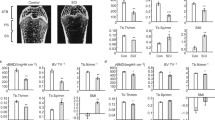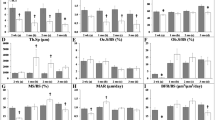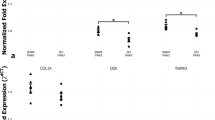Abstract
Summary
Spinal cord injury causes severe bone loss. We report osteoclast resorption with severe trabecular and cortical bone loss, decreased bone mineral apposition, and growth plate abnormalities in a rodent model of contusion spinal cord injury. These findings will help elucidate the mechanisms of osteoporosis following neurological trauma.
Introduction
Limited understanding of the mechanism(s) that underlie spinal cord injury (SCI)-induced bone loss has led to few treatment options. As SCI-induced osteoporosis carries significant morbidity and can worsen already profound disability, there is an urgency to advance knowledge regarding this pathophysiology.
Methods
A clinically relevant contusion model of experimental spinal cord injury was used to generate severe lower thoracic SCI by weight-drop (10 g × 50 mm) in adolescent male Sprague-Dawley rats. Body weight and gender-matched naïve (no surgery) rats served as controls. Bone microarchitecture was determined by micro-computed tomographic imaging. Mature osteoclasts were identified by TRAP staining and bone apposition rate was determined by dynamic histomorphometry.
Results
At 10 days post-injury we detected a marked 48% decrease in trabecular bone and a 35% decrease in cortical bone at the distal femoral metaphysis by micro-CT. A 330% increase in the number of mature osteoclasts was detected at the growth plate in the injured animals that corresponded with cellular disorganization at the chondro-osseous junction. Appositional growth studies demonstrated decreased new bone formation with a mineralization defect indicative of osteoblast dysfunction.
Conclusions
Contusion SCI results in a rapid bone loss that is the result of increased bone resorption and decreased bone formation.




Similar content being viewed by others
References
Szollar SM, Martin EM, Sartoris DJ, Parthemore JG, Deftos LJ (1998) Bone mineral density and indexes of bone metabolism in spinal cord injury. Am J Phys Med Rehabil 77(1):28–35, January
Aluisio FV, Scully SP (1996) Acute hematogenous osteomyelitis of a closed fracture with chronic superinfection. Clin Orthop Relat Res 325:239–244, April
Cochran TP, Bayley JC, Smith M (1988) Lower extremity fractures in paraplegics: pattern, treatment, and functional results. J Spinal Disord 1(3):219–223
Garland DE, Saucedo T, Reiser TV (1986) The management of tibial fractures in acute spinal cord injury patients. Clin Orthop Relat Res 213:237–240, December
Givre S, Freed HA (1989) Autonomic dysreflexia: a potentially fatal complication of somatic stress in quadriplegics. J Emerg Med 7(5):461–463, September
Watson FM, Whitesides TE Jr (1976) Acute hematogenous osteomyelitis complicating closed fractures. Clin Orthop Relat Res 117:296–302, June
Garland DE, Adkins RH, Kushwaha V, Stewart C (2004) Risk factors for osteoporosis at the knee in the spinal cord injury population. J Spinal Cord Med 27(3):202–206
Warden SJ, Bennell KL, Matthews B, Brown DJ, McMeeken JM, Wark JD (2002) Quantitative ultrasound assessment of acute bone loss following spinal cord injury: a longitudinal pilot study. Osteoporos Int 13(7):586–592, July
Vico L, Collet P, Guignandon A, Lafage-Proust MH, Thomas T, Rehaillia M, Alexandre C (2000) Effects of long-term microgravity exposure on cancellous and cortical weight-bearing bones of cosmonauts. Lancet 355(9215):1607–1611, May 6
Leblanc AD, Schneider VS, Evans HJ, Engelbretson DA, Krebs JM (1990) Bone mineral loss and recovery after 17 weeks of bed rest. J Bone Miner Res 5(8):843–850, August
Biering-Sorensen F, Bohr HH, Schaadt OP (1990) Longitudinal study of bone mineral content in the lumbar spine, the forearm and the lower extremities after spinal cord injury. Eur J Clin Invest 20(3):330–335, June
Dauty M, Perrouin VB, Maugars Y, Dubois C, Mathe JF (2000) Supralesional and sublesional bone mineral density in spinal cord-injured patients. Bone 27(2):305–309, August
de Bruin ED, Frey-Rindova P, Herzog RE, Dietz V, Dambacher MA, Stussi E (1999) Changes of tibia bone properties after spinal cord injury: effects of early intervention. Arch Phys Med Rehabil 80(2):214–220, February
Demirel G, Yilmaz H, Paker N, Onel S (1998) Osteoporosis after spinal cord injury. Spinal Cord 36(12):822–825, December
Wilmet E, Ismail AA, Heilporn A, Welraeds D, Bergmann P (1995) Longitudinal study of the bone mineral content and of soft tissue composition after spinal cord section. Paraplegia 33(11):674–677, November
Andresen EM, Patrick DL, Carter WB, Malmgren JA (1995) Comparing the performance of health status measures for healthy older adults. J Am Geriatr Soc 43(9):1030–1034, September
Karsenty G (2000) The central regulation of bone remodeling. Trends Endocrinol Metab 11(10):437–439, December
Battaglino R, Fu J, Spate U, Ersoy U, Joe M, Sedaghat L, Stashenko P (2004) Serotonin regulates osteoclast differentiation through its transporter. J Bone Miner Res 19(9):1420–1431, September
Battaglino R, Vokes M, Schulze-Spate U, Sharma A, Graves D, Kohler T, Muller R, Yoganathan S, Stashenko P (2007) Fluoxetine treatment increases trabecular bone formation in mice. J Cell Biochem 100(6):1387–1394, April 15
Cherruau M, Facchinetti P, Baroukh B, Saffar JL (1999) Chemical sympathectomy impairs bone resorption in rats: a role for the sympathetic system on bone metabolism. Bone 25(5):545–551, November
Cherruau M, Morvan FO, Schirar A, Saffar JL (2003) Chemical sympathectomy-induced changes in TH-, VIP-, and CGRP-immunoreactive fibers in the rat mandible periosteum: influence on bone resorption. J Cell Physiol 194(3):341–348, March
Hill EL, Elde R (1991) Distribution of CGRP-, VIP-, D beta H-, SP-, and NPY-immunoreactive nerves in the periosteum of the rat. Cell Tissue Res 264(3):469–480, June
Hill EL, Turner R, Elde R (1991) Effects of neonatal sympathectomy and capsaicin treatment on bone remodeling in rats. Neuroscience 44(3):747–755
Nockels R, Young W (1992) Pharmacologic strategies in the treatment of experimental spinal cord injury. J Neurotrauma 9(Suppl 1):S211–S217, March
Thompson MK, Tuma RF, Young WF (1999) The effects of pentoxifylline on spinal cord blood flow after experimental spinal cord injury. J Assoc Acad Minor Phys 10(1):23–26
Hulsebosch CE, Xu GY, Perez-Polo JR, Westlund KN, Taylor CP, McAdoo DJ (2000) Rodent model of chronic central pain after spinal cord contusion injury and effects of gabapentin. J Neurotrauma 17(12):1205–1217, December
Mills CD, Grady JJ, Hulsebosch CE (2001) Changes in exploratory behavior as a measure of chronic central pain following spinal cord injury. J Neurotrauma 18(10):1091–1105, October
Pikov V, Wrathall JR (2001) Coordination of the bladder detrusor and the external urethral sphincter in a rat model of spinal cord injury: effect of injury severity. J Neurosci 21(2):559–569, January 15
Pikov V, Wrathall JR (2002) Altered glutamate receptor function during recovery of bladder detrusor-external urethral sphincter coordination in a rat model of spinal cord injury. J Pharmacol Exp Ther 300(2):421–427, February
Choi H, Liao WL, Newton KM, Onario RC, King AM, Desilets FC, Woodard EJ, Eichler ME, Frontera WR, Sabharwal S, Teng YD (2005) Respiratory abnormalities resulting from midcervical spinal cord injury and their reversal by serotonin 1A agonists in conscious rats. J Neurosci 25(18):4550–4559, May 4
Teng YD, Lavik EB, Qu X, Park KI, Ourednik J, Zurakowski D, Langer R, Snyder EY (2002) Functional recovery following traumatic spinal cord injury mediated by a unique polymer scaffold seeded with neural stem cells. Proc Natl Acad Sci USA 99(5):3024–3029, March 5
Ruegsegger P, Koller B, Muller R (1996) A microtomographic system for the nondestructive evaluation of bone architecture. Calcif Tissue Int 58(1):24–29, January
Kohler T, Beyeler M, Webster D, Muller R (2005) Compartmental bone morphometry in the mouse femur: reproducibility and resolution dependence of microtomographic measurements. Calcif Tissue Int 77(5):281–290, November
Villanueva AR, Mehr LA (1977) Modifications of the Goldner and Gomori one-step trichrome stains for plastic-embedded thin sections of bone. Am J Med Technol 43(6):536–538, June
Dietz V, Curt A (2006) Neurological aspects of spinal-cord repair: promises and challenges. Lancet Neurol 5(8):688–694, August
Jiang SD, Jiang LS, Dai LY (2007) Effects of spinal cord injury on osteoblastogenesis, osteoclastogenesis and gene expression profiling in osteoblasts in young rats. Osteoporos Int 18(3):339–349, March
Duval-Beaupere G, Lougovoy J, Trocellier L, Lacert P (1983) Trunk and leg growth in children with paraplegia caused by spinal cord injury. Paraplegia 21(6):339–350, December
Eser P, Schiessl H, Willnecker J (2004) Bone loss and steady state after spinal cord injury: a cross-sectional study using pQCT. J Musculoskelet Neuronal Interact 4(2):197–198, June
Eser P, Frotzler A, Zehnder Y, Schiessl H, Denoth J (2005) Assessment of anthropometric, systemic, and lifestyle factors influencing bone status in the legs of spinal cord injured individuals. Osteoporos Int 16(1):26–34, January
Verhas M, Martinello Y, Mone M, Heilporn A, Bergmann P, Tricot A, Schoutens A (1980) Demineralization and pathological physiology of the skeleton in paraplegic rats. Calcif Tissue Int 30(1):83–90
Takahashi H, Yamamuro T, Okumura H, Kasai R, Tada K (1990) Bone blood flow after spinal paralysis in the rat. J Orthop Res 8(3):393–400, May
Demulder A, Guns M, Ismail A, Wilmet E, Fondu P, Bergmann P (1998) Increased osteoclast-like cells formation in long-term bone marrow cultures from patients with a spinal cord injury. Calcif Tissue Int 63(5):396–400, November
Serre CM, Farlay D, Delmas PD, Chenu C (1999) Evidence for a dense and intimate innervation of the bone tissue, including glutamate-containing fibers. Bone 25(6):623–629, December
Chenu C (2002) Glutamatergic regulation of bone resorption. J Musculoskelet Neuronal Interact 2(5):423–431, September
Lundberg P, Lerner UH (2002) Expression and regulatory role of receptors for vasoactive intestinal peptide in bone cells. Microsc Res Tech 58(2):98–103, July 15
Adam C, Llorens A, Baroukh B, Cherruau M, Saffar JL (2000) Effects of capsaicin-induced sensory denervation on osteoclastic resorption in adult rats. Exp Physiol 85(1):62–66, January
Acknowledgements
We would like to thank Dr. M.van der Vlies and Justine Dobeck for technical assistance and the Swiss National Science Foundation.
Funding
Grant sponsor: NIH/NICHD Grant number K12 HD001097-08 (L.M.);
Grant sponsor: VABLR&D121F (Y.D.T.);
Grant sponsor: NIH Grant number R21NS53935 (Y.D.T.);
Grant sponsor: NIH/NICDR Grant number DE007378-18 (P.S.)
Author information
Authors and Affiliations
Corresponding author
Rights and permissions
About this article
Cite this article
Morse, L., Teng, Y.D., Pham, L. et al. Spinal cord injury causes rapid osteoclastic resorption and growth plate abnormalities in growing rats (SCI-induced bone loss in growing rats). Osteoporos Int 19, 645–652 (2008). https://doi.org/10.1007/s00198-007-0494-x
Received:
Accepted:
Published:
Issue Date:
DOI: https://doi.org/10.1007/s00198-007-0494-x




